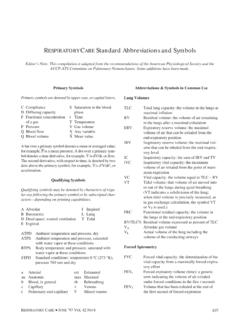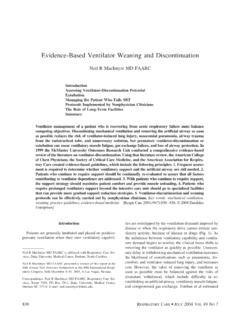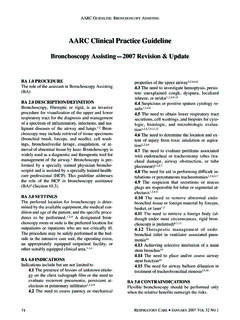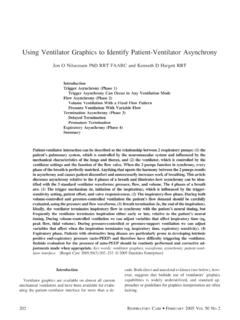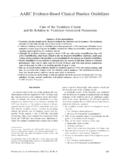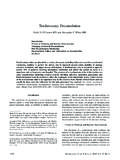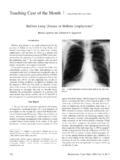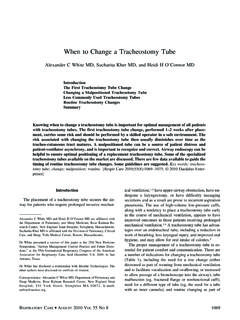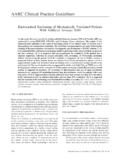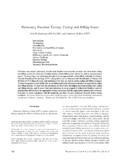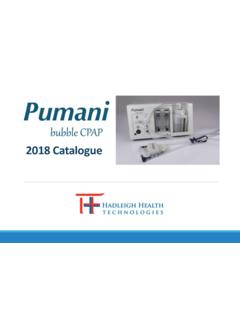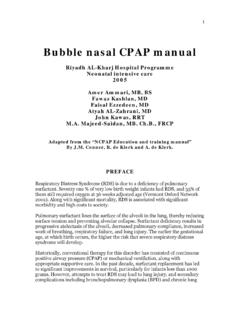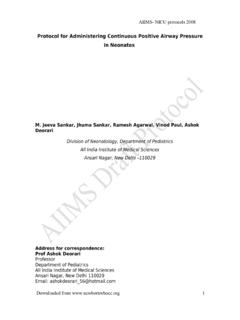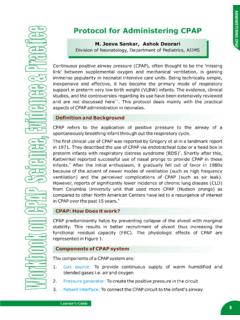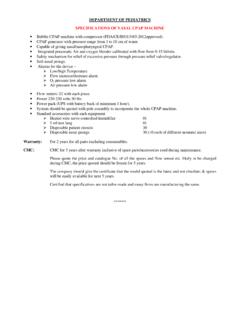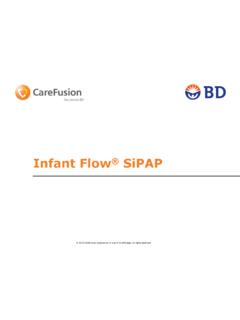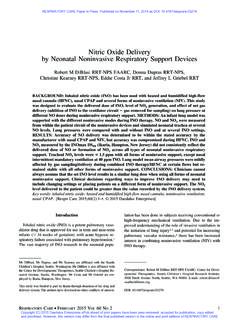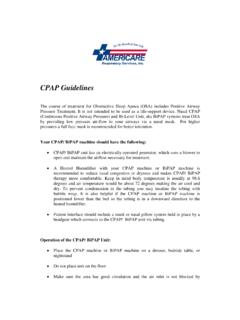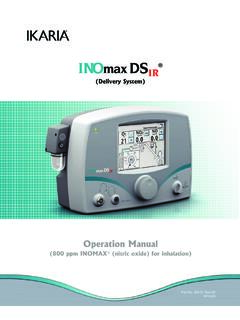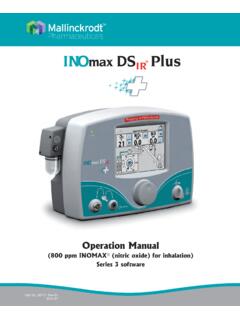Transcription of AARC Clinical Practice Guideline - rcjournal.com
1 AARC Guideline : NEONATALCPAP1100 RESPIRATORYCARE SEPTEMBER2004 VOL49 NO9 NCPAP PROCEDURE:The application of continuous positive airway pres-sure to neonates and infants by nasal prongs(NCPAP), nasopharyngeal tube (NP- cpap ), or in-fant nasal mask (NM- cpap ) administered with acommercially available circuit used in conjunctionwith a continuous flow source, infant ventilator, ora suitably equipped multipurpose DESCRIPTION/DEFINITION: continuous positive airway pressure ( cpap ) is theapplication of positive pressure to the airways of thespontaneously breathing patient throughout the res-piratory the most part, neonates arepreferential nose breathers, which easily facilitatesthe application of nasal is accom-plished by inserting nasopharyngeal tubes, affixingnasal prongs, or fitting a nasal mask to the device provides heated and humidified contin-uous or variable flow from a circuit connected to acontinuous gas source, mechanical ventilator de-signed for neonates, or a suitably equipped multi-purpose ventilator, set in the cpap maintains inspiratory and expiratory pres-sures above ambient pressure .
2 Which results in anincrease in functional residual capacity (FRC) andimprovement in static lung compliance, and de-creased airway resistance in the infant with unstablelung ,3,14-23 This allows a greater volumechange per unit of pressure change (ie, greater tidalvolume for a given pressure change) with subse-quent reduction in the work of breathing and stabi-lization of minute ventilation (YE).13,24-28 cpap in-creases mean airway pressure , and the associatedincrease in FRC should improve ventilation-perfu-sion relationships and potentially reduce oxygen ,25,29-33 Additionally cpap may expand,or stent, upper airway structures preventing col-lapse and upper airway ,28,34,35 NCPAP SETTINGS:NCPAP, NP- cpap , and NM- cpap are applied bytrained personnel in acute and subacute care on physical examination the presence of increased work of breathing asindicated by an increase in respiratory rate of >30% of normal, substernal and suprasternal re-tractions, grunting, and nasal flaring.
3 13,20-23,28,33,34,36the presence of pale or cyanotic skin color andagitation30,32,33, arterial blood gas values theinability to maintain a PaO2> 50 torr with FIO2of provided YEis adequate as indicatedby a PaCO2level of 50 torr and a pH , presence of poorly expanded and/orinfiltrated lung fields on chest radiograph25,37, presence of a condition thought to beresponsive to cpap and associated with oneor more of the Clinical presentations in ,19, Respiratory distress syndrome13-15, edema13, ,37, of prematurity6,23,33, extubation17, malacia or other similarabnormality of the lower airways13, tachypnea of the new-born13, intervention in conjunction with sur-factant administration for very low birthweightinfants at risk for developing respiratory dis-tress ,13,19, administration of controlled concentra-tions of nitric oxide in spontaneously Clinical Practice GuidelineApplication of continuous positive airway pressure to Neonates viaNasal Prongs, Nasopharyngeal Tube, or Nasal Mask 2004 Revision &UpdateAARC Guideline .
4 NEONATALCPAP1101 RESPIRATORYCARE SEPTEMBER2004 VOL49 NO9 NCPAP NCPAP, NP- cpap , and NM- cpap have been used in bronchiolitis, this ap-plication may be , need for intubation and/or mechani-cal ventilation as evidenced by the airway abnormalities thatmake NCPAP, NP- cpap , or NM- cpap ineffective or potentially dangerous (eg,choanal atresia, cleft palate, tracheoe-sophageal fistula) cardiovascular instabilityand impending respiratory drive with fre-quent apneic episodes resulting in desatu-ration and/or failure as indicated bythe inability to maintain PaCO2< 60 torrand pH > , of NCPAP, NP- cpap , or NM- cpap to patients with untreated congenital di-aphragmatic hernia may lead to gastric disten-tion and further compromise of thoracic HAZARDS/ and complications associated withequipment include the of nasal prongs frommucus plugging or kinking of nasopha-ryngeal tube may interfere with deliveryof cpap and result in a decrease in FIO2through entrainment of room air via oppo-site naris or of airway resistance created byturbulent flow through the small ori-fices of nasal prongs and nasopharyn-geal tubes can maintain pressure in theCPAP system even when decannula-tion has occurred.
5 This can result infailure of low airway pressure /discon-nect alarms to obstruction of nasalprongs and nasopharyngeal tubes re-sults in continued pressurization of theCPAP system without activation of lowor high airway pressure of a manual breath (com-monly available on infant ventilators)may cause gastric insufflation and patientdiscomfort particularly if the peak pres-sure is set inappropriately gas flow to meet inspi-ratory demand resulting in a fluctuatingbaseline pressure and an increase in thework of flow results in overdis-tension from increased work of breathingdue to incomplete exhalation and inadver-tent PEEP or malpositioning ofprongs or nasopharyngeal tubes causingfluctuating or reduced cpap or accidental swallowingof small pieces of the detachable circuit ornasal device excoriation, scarring, pressurenecrosis, and septal distortion73.
6 Irritation of the head and neckfrom improperly secured bonnets orCPAP head and complications associated withthe patient s Clinical condition overdistention leading leak and increasedwork of breathing7,30, of pulmonary bloodflow with a subsequent increase in pul-monary vascular resistance and de-crease in cardiac output39, insufflation and abdominaldistention potentially leading to aspira-tion34,81, mucosal damage due to inade-quate humidification18 NCPAP LIMITATIONS OF , NP- cpap , and NM- cpap applica-tions are not benign procedures, and operatorsshould be aware of the possible hazards andcomplications and take all necessary precau-tions to ensure safe and effective breathing during NCPAP, NP- cpap ,and NM- cpap may result in loss of desiredpressure and decrease in delivered oxygen con-AARC Guideline .
7 NEONATALCPAP1102 RESPIRATORYCARE SEPTEMBER2004 VOL49 ,86-89 However, most studies demon-strate effective NCPAP without mouth harnesses and attachment devicesare often cumbersome and difficult to secureand may cause agitation and result in inadver-tent ,11, Excessive head rotation or neck extensionmay alter the position of NP- cpap tube place-ment or obstruct upper airway structures result-ing in diminished or altered pressure , flow, andeffective , Severe RDS, septicemia during NCPAP ad-ministration, and pneumothorax are risk factorsassociated with NCPAP ,79,90 NCPAP ASSESSMENT OF NEED:Determination that valid indications are present byphysical, radiographic, and laboratory ASSESSMENT OF OUTCOME.
8 cpap is initiated at levels of 4-5 cm H2O and maybe gradually increased up to 10 cm H2O to providethe following13,25,30,33,59,86, of FIO2requirement PaO2levels > 50 torr and/or the presence ofclinically acceptable noninvasive monitoring ofoxygen (PtcO2), while maintaining an adequateYEas indicated by PaCO2of 50-60 torr or lessand pH ,29,64, in the work of breathing as indi-cated by a decrease in respiratory rate by 30-40% and a decrease in the severity of retrac-tions, grunting, and nasal flaring33,37, in lung volumes and appear-ance of lung as indicated by chest radiograph19, in patient comfort as assessedby bedside Clinically significant reduction in apnea,bradycardia, and cyanosis episodesNCPAP tubes (positioned inthe nasopharynx and secured by taping,with placement verified by laryngoscopyor palpation)
9 Or commercially availablenasal prongs, bilateral nasopharyngealtubes, or specially designed nasal maskswith accompanying harness and acces-sories may be used for cpap ,17,19,50, nasopharyngealprongs may be less effective in pre-venting extubation failure than bilateralshort ,98, flow air-oxygen gassource; commercially available continu-ous-flow infant ventilators equipped withCPAP mode; cpap flow driver with flu-idic nasal interface, or suitably equippedmultipurpose ventilator, with integratedor adjunct low and high airway pressurealarms, oxygen concentration analyzerwith low and high alarms, loss of powerand gas source alarms14,19,100, continuous gas flow sourcerequires a mechanical pressure limitingdevice, or a flow or threshold resistor,which includes the use of an underwa-ter threshold resistor, eg cpap or ventilatorcircuits with servo-regulated humidifica-tion noninvasive oxygena-tion monitoring by pulse oximetry or tran-scutaneous monitor with high and lowalarm capabilities is recommended (con-tinuous transcutaneous CO2monitoringmay also be utilized).
10 101, electrocardiographicand respiratory rate monitor, with highand low alarm capabilities, is source, suction regulator,and suction catheters for periodic suction-ing to assure patency of nasal passagesand of endotracheal tubes used for NP- cpap are apparatus with air-way manometer and masks of appropriatesize must be tube for periodic decom-pression of stomach and chest tubesshould be : The application of NCPAP,NP- cpap , and NM- cpap should be performedunder the direction of a physician by trainedpersonnel who hold a recognized credentialAARC Guideline : NEONATALCPAP1103 RESPIRATORYCARE SEPTEMBER2004 VOL49 NO9(eg, CRT, RRT, RN) and who use, understanding, andmastery of the technical aspects of cpap devices, mechanical ventilators, and hu-midification of ventilator man-agement and understanding of neonatalairway anatomy and pulmonary assessment skills, with anunderstanding of the interaction betweenthe cpap device and the patient and theability to recognize and respond to ad-verse reactions and and understanding ofartificial airway management, training inthe procedures of placing endotrachealtubes in the ability to interpret monitoredand measured blood gas values and application of Standard use, understanding, andmastery of emergency resuscitationequipment and ability to assess, evaluate.
